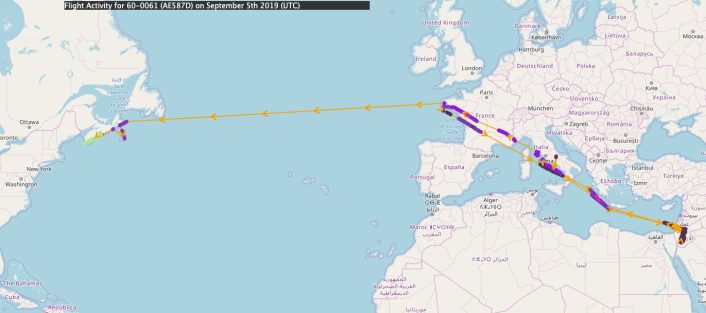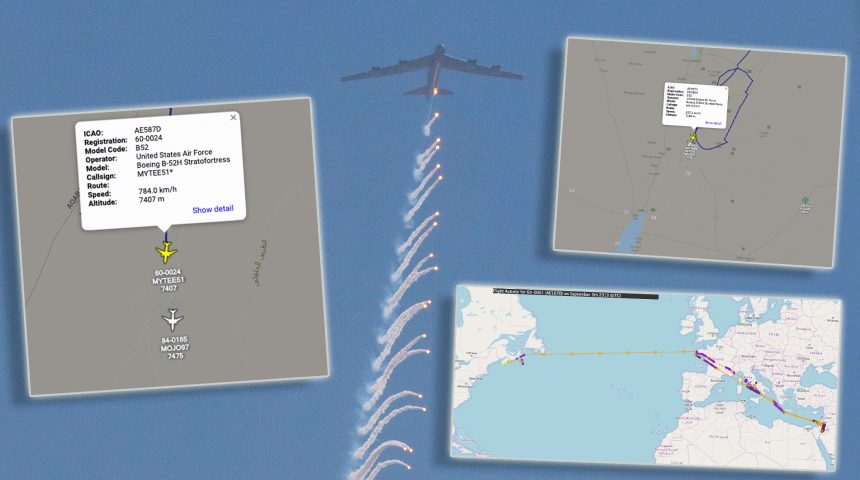Flying from its homebase in the U.S. the heavy bomber once again integrated in the drills. But this time it could tracked online as it flew over Jordan.
A U.S. Air Force Boeing B-52 Stratofortress, from the 2nd Bomb Wing, Barksdale Air Force Base, Louisiana, took part in a flyover at the combined arms live fire exercise at the end of Exercise Eager Lion 19 in Amman, Jordan, on Sept. 5, 2019.
Eager Lion is a recurring (yearly), 2-week multinational exercise designed to strengthen military-to-military relationships, increase interoperability between partner nations, and enhance regional security and stability. It takes place since 2010 and sees the participation of the B-52 heavy bombers, involved in round-robin missions from their bases in CONUS (Continental US) since 2015, when two “Buffs” performed a 30-plus hour, 14,000 mile nonstop mission to the U.S. Central Command area of operations, dropped some 500-lb GBU-38 JDAMs (Joint Direct Attack Munitions) over Wadi Shadiya range, and returned home. A similar mission was carried out in 2016 and 2018 (in 2017, the long range mission was conducted by Ellsworth AFB’s B-1 Lancers.
Several interesting details about this year’s show of force mission could be gathered online using OSINT (Open Sources Intelligence) tools, such as flight tracking websites and applications and web-based radios.
The first interesting thing is that this time, just one of the B-52s which were tasked with the EL19 mission eventually crossed the Pond, since the other one had to return home (for unknown reasons):
23.01
MYTEE51 just confirmed with GANDER ATC he is now single ship, other B-52 had to RTB…
— SR Airband & Aviation 📡✈🌍 (@Andy007_SR_A) September 4, 2019
The remaining B-52, flying as MYTEE 51, continued its mission, took part in the live fire exercise (during which it most probably integrated with Royal Jordanian Air Force F-16s (as happened in the past years) and returned home.
Interestingly, the aircraft could also be tracked as it was refueled over Jordan, south of Amman, by two KC-10 tankers, MOJO98 (791712) and MOJO97 (840185), before taking the way back home via the Eastern Mediterranean Sea.
The AAR (Air-to-Air Refueling) operation took place in the FL220-250 block, between 09.15Z and 10.10Z, when the three aircraft declared MARSA (military assumes responsibility separation aircraft). MARSA is used when two or more IFR aircraft need to operate near each other with less than standard IFR separation. Once MARSA is declared the ATC controller may allow the aircraft to operate as they desire with respect to one another. During the rendezvous, controllers should not issue any instructions to the aircraft involved and, once the rendezvous is complete, issue instructions to the lead aircraft.
🇺🇸 ✈ U.S. Air Force | 2BW | 20BS Boeing B-52H Stratofortress (60-0024, AE587D) as flight #MYTEE51* in #AAR by 2X 🇺🇸 ✈ #USAF Douglas KC-10A Extender (84-0185, AE0219) #MOJO97 and (79-1712, AE01DD) #MOJO98 South of 🇯🇴 #Jordan. pic.twitter.com/AtCE2DK7Zz
— INTELSky 🛰️ (@Intel_Sky) September 5, 2019
Under MARSA, when the aircraft would like to separate, they position themselves so that standard ATC separation exists and once the controller has standard separation, he advises that MARSA is terminated, and assumes responsibility for separation between the aircraft. As happened on Sept. 5, after AAR. The three aircraft separated and the B-52 headed back climbing to FL280.

Interestingly, during the flight, there was some confusion around the actual ID of the B-52H (don’t forget that by knowing the aircraft serial number/registration you can also know whether it is a denuclearized bomber or not). In fact, during the first and last part of the flight, MYTEE 51 was identified as 60-0061 while during the transition across the Med Sea over Israel and Jordan, the aircraft identification was 60-0024. ADSBExchange.com shows the history of flight with hex code AE587D as 60-0061. There must be some confusion as to the aircraft actually using the hex code, although this was visually identified as 60-0024 in the recent past.
Someone noticed this:
Well, that’s curious. When I first double-checked, the B-52 was identified as 60-0061. Four minutes later the ID had been changed to 60-0024. I guess IDs sometime change. pic.twitter.com/2QFiOfvfQV
— Hans Kristensen (@nukestrat) September 5, 2019
It’s not the first time B-52s could be tracked during long range missions. For instance, the B-52s deploying to Al Udeid, Qatar, in response to “troubling and escalatory indications and warnings” related to Iran, could be tracked online during their ferry flight last May.









